لسٹ فراعین مصر
| فرعون مصر | |
|---|---|
| سابقہ بادشاہت | |

| |
| The Pschent combined the Red Crown of تھلواں مصر and the White Crown of اتلا مصر۔ | |
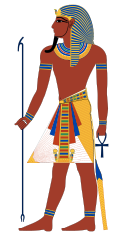
| |
| A typical depiction of a pharaoh. | |
| اولین بادشاہ/ملکہ | نارمر (a.k.a. Menes) |
| آخری بادشاہ/ملکہ | Nectanebo II (last native)[۱] Cleopatra & Caesarion (last actual) |
| انداز | Five-name titulary |
| سرکاری رہائش گاہ | Varies by era |
| تقرر کنندہ | Divine right |
| بادشاہت دا آغاز | c. 3100 BC |
| بادشاہت دا آختتام | 343 BC (last native pharaoh)[۱] 30 BC (last Greek pharaohs) |
ایہ فہرست فراعنہ مصر (List of pharaohs) اے۔ فرعون دا لقب قدیم مصر دے بادشاہاں لئی استعمال ہندا اےـ لغوی معنی "عظیم گھر" نیں جس توں مراد بادشاہ دا محل سی ۔ سمجھا جاندا سی کہ سارے فرعون مصری دیوتےآں دی اولاد نیں ـ[۲]
Legendary period
سودھوIn the texts of the Palermo، Turin and Manetho king lists, there are different versions of names of eight god kings that ruled Egypt in the beginning.[حوالہ درکار]
| Turin King list | Manetho (Greek equivalent) |
Function |
|---|---|---|
| پتاح | Hephestus (پتاح) |
Craftsmen & Creation |
| رع | Helios (Apollo) |
Sun |
| Shu | Aelos or Agathosdaimon (perhaps Sothis?) (Shu) |
Air |
| دیوتا گب | Gaia (Demeter) |
Earth |
| اوزیریس | Hades | Afterlife |
| Set | طائفون (Set) |
Chaos |
| حورس | Ares | War |
| تحوت | ایتھنے | Knowledge |
| ماعت | Order |
These god kings are followed by differing sets of semi-divine rulers.
| Turin King List | Length | Manetho | Length |
|---|---|---|---|
| Second dynasty of gods | unknown | Dynasty of Halfgods | unknown |
| 3 Achu-Dynasties | unknown | 30 Kings from Memphis | 1790 years |
| Dynasty of Disciples of حورس | unknown | 10 Kings from تینیس | 350 years |
Archaic period
سودھوThe Archaic period includes the Early Dynastic Period، when زیریں مصر and بالائی مصر were ruled as separate kingdoms.
Early Dynastic: Lower Egypt
سودھوزیریں مصر consisted of the northern دریائے نیل and the Nile Delta۔ The following list may not be complete:
| نام | Comments | Dates |
|---|---|---|
| Hsekiu[۳] | Only known from the Palermo stone | ? |
| Khayu[۳] | Only known from the Palermo stone | ? |
| Tiu[۳] | Only known from the Palermo stone | ? |
| Thesh[۳] | Only known from the Palermo stone | ? |
| Neheb[۳] | Only known from the Palermo stone | ? |
| Wazner[۳] | Only known from the Palermo stone | c. 3100 BC? |
| Mekh[۳] | Only known from the Palermo stone | ? |
| (destroyed)[۳] | Was only known from the Palermo stone | ? |
| Double Falcon | Attested through finds from Sinai and Lower Egypt | c. 3200 BC? |
Early Dynastic: Upper Egypt
سودھوبالائی مصر consisted of the Nile Valley, south of the Delta. The following list may not be complete (there are many more of uncertain existence):
| Name | Image | Comments | Dates |
|---|---|---|---|
| Scorpion I | Oldest tomb at Umm el-Qa'ab had scorpion insignia | c. 3200 BC? | |
| Iry-Hor |  |
Possibly the immediate predecessor of Ka. | c. 3150 BC? |
| Ka[۴][۵] | 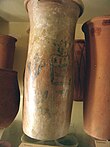 |
Maybe read Sekhen rather than Ka. Possibly the immediate predecessor of Narmer. | c. 3100 BC |
| King Scorpion |  |
Potentially read Serqet; possibly the same person as نارمر۔ | c. 3150 BC |
| نارمر |  |
The king who combined Upper and Lower Egypt.[۶] | c. 3150 BC |
First Dynasty
سودھوThe First Dynasty ruled from approximately 3150 to 2890 BC, by some chronological schemes. (There are no precise or agreed-upon year dates for any of the Old or Middle Kingdom periods, and reign estimates differ widely from one Egyptologist to the next.)
| Name | Image | Comments | Dates |
|---|---|---|---|
| نارمر |  |
Believed to be the same person as Menes and to have unified Upper and Lower Egypt. | c. 3150 BC |
| Hor-Aha | 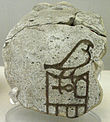 |
— | c. 3050 BC |
| Djer | 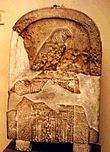 |
— | 41 years |
| Djet |  |
— | 10 years[۷] |
| Merneith | 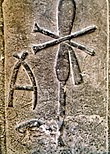 |
Female Regent for Den, may have ruled as pharaoh in her own right | — |
| Den |  |
First pharaoh depicted wearing the double crown of Egypt, first pharaoh with a golden Horus name. | 42 years[۷] |
| Anedjib |  |
— | 10 years |
| Semerkhet | 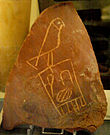 |
— | 9 years |
| Qa'a | 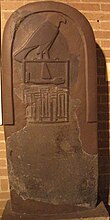 |
— | 2916?–2890 BC |
In the interregnum between the first and second dynasties two short lived pharaohs may have reigned :
| Name | Image | Comments | Dates |
|---|---|---|---|
| Sneferka | 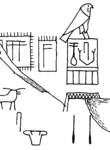 |
Very short reign | c. 2900 BC |
| Horus Bird | 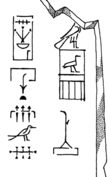 |
Very short reign | c. 2900 BC |
Second Dynasty
سودھوThe Second Dynasty ruled c. 2890–2686 BC.
| Name | Image | Comments | Dates |
|---|---|---|---|
| Hotepsekhemwy[۸] | 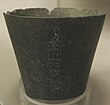 |
— | 25–29 years |
| Raneb[۹] | 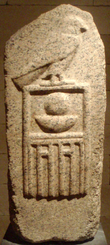 |
Name may be read Nebra rather than Raneb. Could be the same person as Weneg.[۱۰] | 10–14 years |
| Nynetjer[۱۱] | 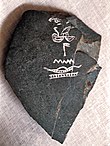 |
May have divided Egypt between his successors | 43–45 years |
| Weneg[۱۲] | 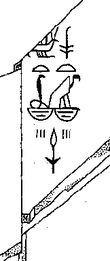 |
Could be an independent ruler or the same as Sekhemib-Perenmaat or Raneb | |
| Senedj[۱۳] |  |
Possibly the same person as Seth Peribsen [۱۴] | |
| Seth-Peribsen[۱۵] |  |
May have reigned over Upper Egypt only, could be the same person as Senedj or Sekhemib-Perenmaat.[۱۶] | |
| Sekhemib-Perenmaat |  |
May have reigned over Upper Egypt only, could be the same person as Seth-Peribsen.[۱۶] | |
| Khasekhem(wy)[۱۷][۱۸] |  |
Reunified Egypt after a period of troubles ca. 2690 BC | 17–18 years |
Old Kingdom
سودھوThe Old Kingdom is the period in the third millennium BC when Egypt attained its first continuous peak of civilisational complexity and achievement (the first of three so-called "Kingdom" periods which mark the high points of civilization in the Nile Valley)، spanning the period when Egypt was ruled by the Third Dynasty through the Sixth Dynasty (2686–2181 BC)۔ Many Egyptologists also include the Memphite Seventh and Eighth Dynasties in the Old Kingdom as a continuation of the administration centralised at Memphis۔ The Old Kingdom was followed by a period of disunity and relative cultural decline referred to by Egyptologists as the First Intermediate Period—or, as the Egyptians called it, the "first illness."
The royal capital of Egypt during the Old Kingdom was located at Memphis، where Djoser established his court. The Old Kingdom is perhaps best known, however, for the large number of pyramids which were constructed at this time as pharaonic burial places. For this reason, the Old Kingdom is frequently referred to as "the Age of the Pyramids"۔
Third Dynasty
سودھوThe Third Dynasty ruled from 2686 to 2613 BC.
| Name | Image | Comments | Dates |
|---|---|---|---|
| Djoser[۱۹][۲۰] |  |
Commissioned the first Pyramid in Egypt The Step Pyramid Constructed by Djosers' chief architect and scribe Imhotep[۲۱] | 19 or 28 years ca. 2670 BC; Radiocarbon dates start reign between 2691 and 2625[۲۲] |
| Sekhemkhet[۲۳] |  |
Imhotep participated in the construction of his unfinished step pyramid | 2649–2643 |
| Sanakhte |  |
Could be the same as Nebka | c. 2650 |
| Khaba | 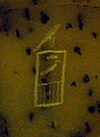 |
Built an unfinished step pyramid | 2643–2637 |
| Huni[۲۴] | 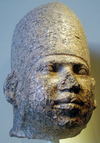 |
Could be the same as Qahedjet، may have started the Meidum pyramid | 2637–2613 |
Fourth Dynasty
سودھوThe Fourth Dynasty ruled from 2613 to 2498 BC and included the pharaohs who had the Great Pyramids built, Khufu (Cheops)، Khafra (Chephren) and منقرع (Mycerinus)۔
| Name | Image | Comments | Dates |
|---|---|---|---|
| سنفرو | 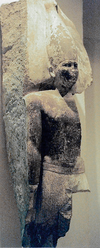 |
Built the Meidum Pyramid and the ہرم سنفرو (341 ft/103m from the base to the tip)، which is a pyramid built at a normal angle at the bottom but drastically changes at the top. He also built the first "true" pyramid, the سرخ ہرم۔ Some say that he was buried in the Red Pyramid, while others say that he was buried in the Bent Pyramid. Bones have been found at the Red Pyramid, but there is no evidence that this is Sneferu's body. | |
| Khufu | 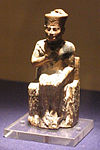 |
Greek form: Cheops۔ Built the great pyramid of Giza۔ Note that Khufu is spoken of in early sources as being "third" of his family to rule, although there is no known record of a Pharaoh between Sneferu and Khufu. One supposition is that there might have been a very short reign of some elder brother of Khufu, whose inscriptions, names, and monuments have perished for one reason or another. | |
| جدفرع (Radjedef) |  |
Believed to have created the Great Sphinx of Giza as a monument for his deceased father. He also created a pyramid at Abu Rawash. However, this pyramid is no longer intact as it is believed the Romans recycled the materials it was made from. Before being demolished by the Romans, according to a documentary aired by the History Channel, the pyramid may actually have been the highest ever built (about 20 meters taller than the Great Pyramid of Giza although this is due to its elevated location rather than the size from base to tip)۔ | |
| Khafre |  |
Greek form: Chephren His pyramid is the second largest in Giza. Credited by some Egyptologists as the builder of the Great Sphinx of Giza۔ | |
| — | – | Here some authorities insert Bikheris، following Manetho | — |
| منقرع |  |
Greek form: Mycerinus۔ His pyramid is the third and smallest in Giza. | |
| Shepseskaf |  |
Broke with the tradition of pyramid building and instead had the Mastabat el-Fara'un made for himself | |
| Djedefptah | – | Here some authorities insert Djedefptah a.k.a. Thampthis، following Manetho | — |
Fifth Dynasty
سودھوThe Fifth Dynasty ruled from 2498 to 2345 BC.
| Name | Image | Comments | Dates |
|---|---|---|---|
| Userkaf | 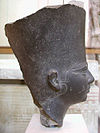 |
Buried in a pyramid in Saqqara۔ Built the first solar temple at Abusir. | |
| Sahure |  |
Moved the royal necropolis to Abusir، where he built his pyramid۔ | |
| Neferirkare Kakai |  |
— | |
| Shepseskare |  |
Reigned most likely after Neferefre and for only a few months.[۲۵] | |
| Neferefre |  |
— | |
| Nyuserre Ini | 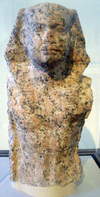 |
— | |
| Menkauhor Kaiu |  |
— | |
| Djedkare Isesi |  |
— | |
| Unas |  |
His pyramid is inscribed with the earliest instance of the ہرمی ادب |
Sixth Dynasty
سودھوThe Sixth Dynasty ruled from 2345 to 2181 BC.
| Name | Image | Comments | Dates |
|---|---|---|---|
| Teti |  |
Was possibly murdered by his successor | |
| Userkare |  |
Reigned 1 to 5 years, may have usurped the throne at the expense of Teti | |
| Meryre Pepi I |  |
— | |
| Merenre Nemtyemsaf I |  |
— | |
| Neferkare Pepi II |  |
Possibly the longest reigning monarch of human history with 94 years on the throne. Alternatively, may have reign "only" 64 years. | |
| Neferka | Only mentioned in the Oxford Encyclopedia of Ancient Egypt۔ Reigned during Pepi II; was possibly his son or co-ruler. | ||
| Merenre Nemtyemsaf II[۲۶] |  |
Short lived pharaoh, possibly an aged son of Pepi II. | |
| Neitiqerty Siptah | 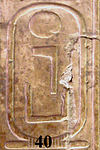 |
Identical with Netjerkare. This male king gave rise to the legendary queen Nitocris of هيرودوت and Manetho۔[۲۷] Sometimes classified as the first king of the combined 7th/8th Dynasties. | Short reign: c. 2184 BC – 2181 BC |
First Intermediate Period
سودھوThe First Intermediate Period (2181–2060 BC) is the period between the end of the Old Kingdom and the advent of the Middle Kingdom۔
The Old Kingdom rapidly collapsed after the death of Pepi II۔ He had reigned for 94 years, longer than any monarch in history, and died aged 100. The latter years of his reign were marked by inefficiency because of his advanced age.
The Union of the Two Kingdoms fell apart and regional leaders had to cope with the resulting famine۔
Around 2160 BC, a new line of pharaohs tried to reunite زیریں مصر from their capital in Herakleopolis Magna۔ In the meantime, a rival line based at Thebes was reuniting بالائی مصر and a clash between the two rival dynasties was inevitable.
Around 2055 BC, Mentuhotep II، the son and successor of pharaoh Intef III defeated the Herakleopolitan pharaohs and reunited the Two Lands, thereby starting the Middle Kingdom.
Seventh and Eighth Dynasties (combined)
سودھوThe Seventh and Eighth Dynasties ruled from c. 2181 to c. 2160 BC. They comprise numerous ephemeral rulers reigning from Memphis over a possibly divided Egypt. This table is based on the Abydos King List dating to the reign of Seti I and taken from Jürgen von Beckerath's Handbuch der ägyptischen Königsnamen[۲۸] as well as from Kim Ryholt's latest reconstruction of the Turin canon، another king list dating to the Ramesside Era۔[۲۹]
| Name | Image | Comments | Dates |
|---|---|---|---|
| Menkare | 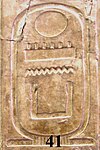 |
||
| Neferkare II | 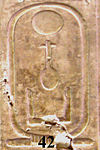 |
||
| Neferkare (III) Neby |  |
Attested by inscriptions in the tomb of his mother Ankhesenpepi, started the construction of a pyramid in Saqqara. | |
| Djedkare Shemai | 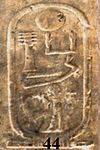 |
||
| Neferkare (IV) Khendu | 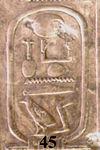 |
||
| Merenhor | 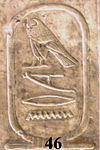 |
Some authorities place Merenhor here | |
| Neferkamin | 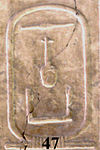 |
||
| Nikare |  |
Possibly attested by a cylinder-seal. | |
| Neferkare (V) Tereru | 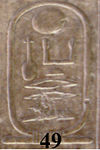 |
||
| Neferkahor |  |
Attested by a cylinder seal. | |
| Neferkare (VI) Pepiseneb |  |
||
| Neferkamin Anu |  |
||
| Qakare Ibi |  |
Built a pyramid at Saqqara inscribed with the last known instance of the ہرمی ادب | 2169–2167 BC |
| Neferkaure |  |
Attested by one to three decrees from the temple of Min at Coptos۔ | 2167–2163 BC |
| Neferkauhor Khuwihapi |  |
Attested by eight decrees from the temple of Min and an inscription in the tomb of Shemay۔ | 2163–2161 BC |
| Neferirkare | 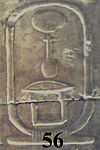 |
Possibly to be identified with horus Demedjibtawy, in which case he is attested by a decree from the temple of Min. | 2161–2160 BC |
Ninth Dynasty
سودھوThe Ninth Dynasty[۳۰] ruled from 2160 to 2130 BC. The Turin King List has 18 kings reigning in the Ninth and Tenth Dynasties. Of these, twelve names are missing and four are partial.[۳۰]
| Name | Image | Comments | Dates |
|---|---|---|---|
| Meryibre Khety I (Acthoes I) |  |
Manetho states that Achthoes founded this dynasty. | 2160–? |
| — | - | ? | |
| Neferkare VII | - | ? | |
| Nebkaure Khety II (Acthoes II) | 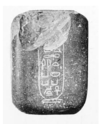 |
- | ? |
| Senenh— or Setut | - | ? | |
| — | - | ? | |
| Mery— | - | ? | |
| Shed— | - | ? | |
| H— | - | ? |
Tenth Dynasty
سودھوThe Tenth Dynasty was a local group that held sway over زیریں مصر that ruled from 2130 to 2040 BC.
| Name | Image | Comments | Dates |
|---|---|---|---|
| Meryhathor | — | 2130–? | |
| Neferkare VIII | — | ? | |
| Wahkare Khety (Acthoes III) | — | ? | |
| Merykare | 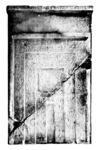 |
— | ?–2040 |
Eleventh Dynasty
سودھوThe Eleventh Dynasty was a local group with roots in بالائی مصر that ruled from 2134 to 1991 BC. The 11th dynasty originated from a dynasty of Theban nomarchs serving kings of the 8th, 9th or 10th dynasty.
| Name | Image | Comments | Dates |
|---|---|---|---|
| Intef the Elder Iry-pat |  |
Theban nomarch serving an unnamed king, later considered a founding figure of the 11th Dynasty. | — |
The successors of Intef the Elder، starting with Mentuhotep I، became independent from their northern overlords and eventually conquered Egypt under Mentuhotep II۔
| Name | Image | Comments | Dates |
|---|---|---|---|
| Mentuhotep I Tepy-a |  |
Nominally a Theban nomarch but may have ruled independently. | |
| Sehertawy Intef I |  |
First member of the dynasty to claim a Horus name. | |
| Wahankh Intef II |  |
Conquered Abydos and its nome. | |
| Nakhtnebtepnefer Intef III |  |
Conquered اسیوط and possibly moved further North up to the 17th nome.[۳۱] |
Middle Kingdom
سودھوThe Middle Kingdom (2060–1802 BC) is the period from the end of the First Intermediate Period to the beginning of the Second Intermediate Period۔ In addition to the Twelfth Dynasty، some scholars include the Eleventh، Thirteenth and Fourteenth Dynasties in the Middle Kingdom. The Middle Kingdom can be noted for the expansion of trade outside of the kingdom that occurred during this time. This opening of trade eventually led to the downfall of the Middle Kingdom, induced by an invasion from the Hyksos۔
Eleventh Dynasty continued
سودھوThe second part of the Eleventh Dynasty is considered to be part of the Middle Kingdom of Egypt.
| Name | Image | Comments | Dates |
|---|---|---|---|
| Nebhetepre Mentuhotep II[۳۲] | 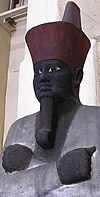 |
Gained all Egypt ca. 2015 BC, Middle Kingdom begins. | |
| Sankhkare Mentuhotep III[۳۳] |  |
Commanded the first expedition to Punt of the Middle Kingdom | |
| Nebtawyre Mentuhotep IV[۳۴] |  |
Obscure pharaoh absent from later king lists; tomb unknown. May have been overthrown by his vizier and successor Amenemhat I۔ |
Twelfth Dynasty
سودھوThe Twelfth Dynasty ruled from 1991 to 1802 BC, and is considered by later Egyptians to have been their greatest dynasty.
| Name | Image | Comments | Dates |
|---|---|---|---|
| Sehetepibre Amenemhat I[۳۵][۳۶] |  |
Seized power after overthrowing Mentuhotep IV. Died assassinated. | |
| Kheperkare Senusret I[۳۷] (Sesostris I) |  |
Built the White Chapel | |
| Nubkaure Amenemhat II[۳۸] |  |
— | |
| Khakheperre Senusret II[۳۹] (Sesostris II) | 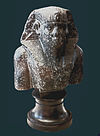 |
— | |
| Khakaure Senusret III[۴۰] (Sesostris III) | 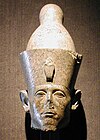 |
Most powerful of the Middle Kingdom pharaohs. | |
| Nimaatre Amenemhat III[۴۱] |  |
— | |
| Maakherure Amenemhat IV[۴۲] |  |
Had a co-regency lasting at least 1 year based on an inscription at Konosso۔ | |
| Sobekkare Sobekneferu[۴۳] |  |
A rare female ruler. |
Second Intermediate Period
سودھوThe Second Intermediate Period (1802–1550 BC) is a period of disarray between the end of the Middle Kingdom، and the start of the New Kingdom۔ It is best known as when the Hyksos، whose reign comprised the Fifteenth، made their appearance in Egypt.
The Thirteenth Dynasty was much weaker than the Twelfth Dynasty، and was unable to hold onto the two lands of Egypt. Either at the start of the dynasty, c. 1805 BC or toward the middle of it in c. 1710 BC, the provincial ruling family in Xois، located in the marshes of the eastern Delta, broke away from the central authority to form the Canaanite Fourteenth Dynasty۔
The Hyksos made their first appearance during the reign of Sobekhotep IV، and around 1720 BC took control of the town of Avaris (the modern Tell el-Dab'a/Khata'na)، conquering the kingdom of the 14th dynasty. Then, some time around 1650 BC the Hyksos, perhaps led by Salitis the founder of the Fifteenth Dynasty, conquered Memphis، thereby terminating the 13th dynasty. The power vacuum in Upper Egypt resulting from the collapse of the 13th dynasty allowed the 16th dynasty to declare its independence in Thebes، only to be overrun by the Hyksos kings shortly thereafter.
Subsequently, as the Hyksos withdrew from Upper Egypt, the native Egyptian ruling house in Thebes set itself up as the Seventeenth Dynasty۔ This dynasty eventually drove the Hyksos back into Asia under Seqenenre Tao, Kamose and finally Ahmose, first pharaoh of the New Kingdom.
Thirteenth Dynasty
سودھوThe Thirteenth Dynasty (following the Turin King List) ruled from 1802 to around 1649 BC and lasted 153 or 154 years according to Manetho. This table should be contrasted with Known kings of the 13th Dynasty
| Name | Image | Comments | Dates |
|---|---|---|---|
| Sekhemre Khutawy Sobekhotep I | 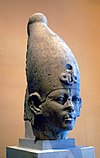 |
Founded the 13th Dynasty. His reign is well attested. Referred to as Sobekhotep I in dominant hypothesis, known as Sobekhotep II in older studies | 1802–1800 BC[۴۴] |
| Sonbef |  |
Perhaps a brother of Sekhemre Khutawy Sobekhotep and son of Amenemhat IV[۴۴] | 1800 BC – 1796 BC[۴۴] |
| Nerikare |  |
1796 BC | |
| Sekhemkare Amenemhat V |  |
3 to 4 years[۴۴] | 1796–1793 BC[۴۴] |
| Ameny Qemau | Buried in his pyramid in south دہشور | 1795–1792 BC | |
| Hotepibre Qemau Siharnedjheritef |  |
Also called Sehotepibre | 1792–1790 BC |
| Iufni | Only attested on the Turin canon | Very short reign, possibly c. 1790 – 1788 BC[۴۴] | |
| Seankhibre Amenemhet VI | — | 1788–1785 BC | |
| Semenkare Nebnuni |  |
— | 1785–1783 BC[۴۴] or 1739 BC[۴۵] |
| Sehetepibre Sewesekhtawy |  |
— | 1783–1781 BC[۴۴] |
| Sewadjkare | Known only from the Turin canon | ||
| Nedjemibre | Known only from the Turin canon | 7 months, 1780 BC[۴۴] or 1736 BC[۴۵] | |
| Khaankhre Sobekhotep |  |
Referred to as Sobekhotep II in dominant hypothesis, known as Sobekhotep I in older studies | Reigned c. 3 years, 1780–1777 BC[۴۴] |
| Renseneb | 4 months | 1777 BC[۴۴] | |
| Awybre Hor I | 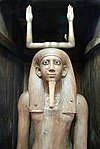 |
Famous for his intact tomb treasure and Ka statue | Reigned 1 year and 6 months, 1777–1775 BC[۴۴] |
| Sekhemrekhutawy Khabaw |  |
Possibly a son of Hor Awibre | Estimated reign 3 years, 1775–1772 BC[۴۴] |
| Djedkheperew |  |
Possibly a son of Hor Awibre and brother of Khabaw, previously identified with Khendjer | Estimated reign 2 years, 1772–1770 BC[۴۴] |
| Sebkay |  |
Possibly two kings, Seb and his son Kay.[۴۴] | |
| Sedjefakare |  |
A well known king attested on numerous stelas and other documents. | 5 to 7 years or 3 years, 1769–1766 BC[۴۴] |
| Khutawyre Wegaf |  |
Founder of the dynasty in old studies | c. 1767 BC |
| Khendjer |  |
Possibly the first سامی قوم pharaoh, built a pyramid at Saqqara | Minimum 4 years and 3 months c. 1765 BC |
| Imyremeshaw | Attested by two colossal statues | Reigned less than 10 years, starting 1759 BC[۴۴] or 1711 BC.[۴۶] | |
| Sehetepkare Intef IV | 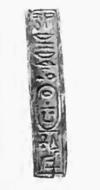 |
— | ? |
| Seth Meribre | — | ? | |
| Sekhemresewadjtawy Sobekhotep III |  |
4 years and 2 months | c. 1755–1751 BC |
| Khasekhemre Neferhotep I | 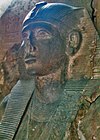 |
11 years | 1751–1740 BC |
| Menwadjre Sihathor | Ephemeral coregent with his brother Neferhotep I, may not have reigned independently. | 1739 BC[۴۴] | |
| Khaneferre Sobekhotep IV |  |
10 or 11 years | 1740–1730 BC |
| Merhotepre Sobekhotep V |  |
— | c. 1730 BC |
| Khahotepre Sobekhotep VI | 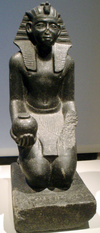 |
4 years 8 months and 29 days | c. 1725 BC |
| Wahibre Ibiau |  |
10 years and 8 months | 1725–1714 BC or 1712–1701 BC[۴۴] |
| Merneferre Ay I |  |
Longest reigning king of the dynasty | 23 years, 8 months and 18 days, 1701–1677 BC[۴۴] or 1714–1691 BC |
| Merhotepre Ini | 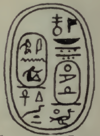 |
Possibly a son of his predecessor | 2 Years 3 or 4 Months and 9 days, 1677–1675 BC[۴۴] or 1691–1689 BC |
| Sankhenre Sewadjtu | Attested only on the Turin canon | 3 years and 2–4 months, 1675–1672 BC[۴۴] | |
| Mersekhemre Ined | 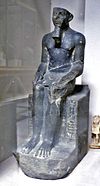 |
May be the same person as Neferhotep II | 3 years, 1672–1669 BC[۴۴] |
| Sewadjkare Hori | 5 years | ? | |
| Merkawre Sobekhotep VII | 2 years and 6 months [۴۴] | 1664–1663 BC[۴۴] | |
| Seven kings | Names lost in a lacuna of the Turin canon [۴۴] | 1663 BC –?[۴۴] | |
| Mer[…]re | — | ? | |
| Merkheperre |  |
— | Some time between 1663 BC and 1649 BC [۴۴] |
| Merkare | — | Some time between 1663 BC and 1649 BC [۴۴] | |
| Name lost | — | ? | |
| Sewadjare Mentuhotep V | 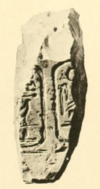 |
— | c. 1655 BC[۴۴] |
| […]mosre | — | ? | |
| Ibi […]maatre | — | ? | |
| Hor[…] […]webenre | — | ? | |
| Se.۔۔kare | ? | ? | |
| Seheqenre Sankhptahi |  |
May be the son of his predecessor | ? |
| ۔۔۔re | ? | ? | |
| Se.۔۔enre | ? | ?–1649 BC [۴۴] |
The position of the following kings is uncertain:
| Name | Image | Comments | Dates |
|---|---|---|---|
| Dedumose I |  |
Possibly a king of the 16th dynasty | c. 1654 |
| Dedumose II |  |
Possibly a king of the 16th dynasty | ? |
| Sewahenre Senebmiu |  |
Late 13th dynasty. | After 1660 BC.[۴۴] |
| Snaaib | 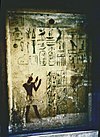 |
Possibly a king of the Abydos Dynasty | ? |
Fourteenth Dynasty
سودھوThe Fourteenth Dynasty was a local group from the eastern Delta, based at Avaris،[۴۷] that ruled from either from 1805 BC or c. 1710 BC until around 1650 BC. The dynasty comprised many rulers with West Semitic names and is thus believed to have been Canaanite in origin.
| Name | Image | Comments | Dates |
|---|---|---|---|
| Yakbim Sekhaenre |  |
Chronological position uncertain, here given as per Ryholt[۴۷] | 1805–1780 BC |
| Ya'ammu Nubwoserre |  |
Chronological position uncertain, here given as per Ryholt[۴۷] | 1780–1770 BC |
| Qareh Khawoserre[۴۷] |  |
Chronological position uncertain, here given as per Ryholt[۴۷] | 1770–1760 BC |
| 'Ammu Ahotepre[۴۷] |  |
Chronological position uncertain, here given as per Ryholt[۴۷] | 1760–1745 BC |
| Sheshi[۴۸] | 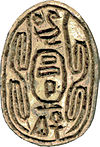 |
Chronological position uncertain, here given as per Ryholt.[۴۷] | 1745–1705 BC |
| Nehesy |  |
Short reign, perhaps a son of Sheshi [۴۷] | c. 1705 |
| سخاوی خاندان | - | ? | |
| سخاوی خاندان | - | c. 1704 | |
| Sehebre | Possibly identifiable with Wazad or Sheneh[۴۴] | - | |
| Merdjefare |  |
Possibly identifiable with Wazad or Sheneh[۴۴] | c. 1699 |
| Sewadjkare III | - | ? | |
| Nebdjefare | - | c. 1694 | |
| Webenre | - | ? | |
| — | - | ? | |
| Djefare? | - | ? | |
| Webenre | c. 1690 | ||
| Sekheperenre[۴۷] | Attested by a single scarab seal | 2 months, some time between 1690 BC and 1649 BC | |
| Anati Djedkare[۴۷] | Only known from the Turin canon | ||
| Bebnum[۴۷] | Only known from the Turin canon | ||
| 'Apepi[۴۷] | Possibly attested as a king's son by 5 scarabs-seals |
The position and identity of the following pharaohs is uncertain:
| Name | Image | Comments | Dates |
|---|---|---|---|
| Nuya[۴۴] | Attested by a scarab-seal | ||
| Wazad[۴۴] | 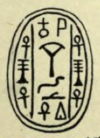 |
May be identifiable with Sehebre or Merdjefare | c. 1700 BC ? |
| Sheneh[۴۴] | 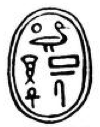 |
May be identifiable with Sehebre or Merdjefare | |
| Shenshek[۴۴] | Attested by a scarab-seal | ||
| Khamure[۴۴] | 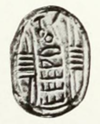 |
||
| Yakareb[۴۴] | 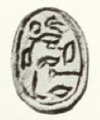 |
||
| Yaqub-Har[۴۸] |  |
May belong to the 14th dynasty، the 15th dynasty or be a vassal of the Hyksos. | 17th–16th centuries BCE |
The Turin King List provides additional names, none of which are attested beyond the list.
Fifteenth Dynasty
سودھوThe Fifteenth Dynasty arose from among the Hyksos people who emerged from the زرخیز ہلال to establish a short-lived governance over much of the Nile region, and ruled from 1674 to 1535 BC.
| Name | Image | Comments | Dates |
|---|---|---|---|
| Semqen |  |
Chronological position uncertain. | 1649 BC – ? |
| 'Aper-'Anat |  |
Chronological position uncertain. | |
| Sakir-Har | - | ? | |
| Khyan |  |
Apex of the Hyksos' power, conquered Thebes toward the end of his reign | 30–40 years |
| Apepi | 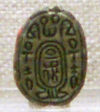 |
- | 40 years or more |
| Khamudi |  |
- | 1555–1544 |
Abydos Dynasty
سودھوThe Second Intermediate Period may include an independent dynasty reigning over Abydos from c. 1650 BC until 1600 BC.[۴۹][۵۰][۵۱] Four attested kings may be tentatively attributed to the Abydos Dynasty, and they are given here without regard for their (unknown) chronological order:
| Name | Image | Comments | Dates |
|---|---|---|---|
| Sekhemraneferkhau Wepwawetemsaf | 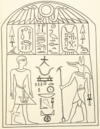 |
May belong to the late 16th Dynasty[۵۲] | |
| Sekhemrekhutawy Pantjeny | 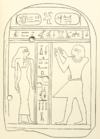 |
May belong to the late 16th Dynasty[۵۲] | |
| Menkhaure Snaaib |  |
May belong to the late 13th Dynasty۔[۵۳][۵۴][۵۵] | |
| Woseribre Senebkay | 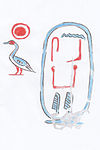 |
Tomb discovered in 2014. Perhaps identifiable with a Woser[…]re of the Turin canon. |
Sixteenth Dynasty
سودھوThe Sixteenth Dynasty was a native Theban dynasty emerging from the collapse of the Memphis-based 13 th dynasty c. 1650 BC and finally conquered by the Hyksos 15th dynasty c. 1580 BC. The 16th dynasty held sway over Upper-Egypt only.
| Name | Image | Comments | Dates |
|---|---|---|---|
| — | Name of the first king is lost here in the Turin King List، and cannot be recovered | ||
| Djehuti Sekhemresementawy | – | 3 years | |
| Sobekhotep VIII Sekhemreseusertawy | 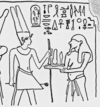 |
– | 16 years |
| Neferhotep III Sekhemresankhtawy | – | 1 year | |
| Mentuhotepi Seankhenre | May be a king of the 17th Dynasty[۵۴] | 1 year | |
| Nebiryraw I Sewadjenre |  |
– | 26 years |
| Nebiriau II | – | ||
| Semenre | – | ||
| Bebiankh Seuserenre |  |
– | 12 years |
| Dedumose I Djedhotepre |  |
May be a king of the 13th Dynasty[۵۴] | |
| Dedumose II Djedneferre |  |
– | |
| Montuemsaf Djedankhre |  |
– | |
| Merankhre Mentuhotep VI |  |
– | |
| Senusret IV Seneferibre |  |
– | |
| Sekhemre Shedwast | – |
The 16th Dynasty may also have comprised the reigns of pharaohs Sneferankhre Pepi III[۵۶] and Nebmaatre۔ Their chronological position is uncertain.[۵۳][۵۴]
Seventeenth Dynasty
سودھوThe Seventeenth Dynasty was based in بالائی مصر and ruled from 1650 to 1550 BC:
| Name | Image | Comments | Dates |
|---|---|---|---|
| Sekhemrewahkhaw Rahotep |  |
- | |
| Sekhemre Wadjkhaw Sobekemsaf I |  |
Reigned at least 7 years | - |
| Sekhemre Shedtawy Sobekemsaf II | His tomb was robbed and burned during the reign of Ramses IX | - | |
| Sekhemre-Wepmaat Intef V |  |
- | - |
| Nubkheperre Intef VI | 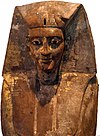 |
Reigned more than 3 years | - |
| Sekhemre-Heruhirmaat Intef VII | 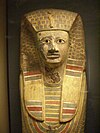 |
- | - |
| Senakhtenre Ahmose | - | - | |
| Seqenenre Tao |  |
Died in battle against the Hyksos. | |
| Kamose | 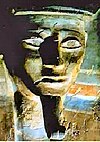 |
The early 17th Dynasty may also have comprised the reign of a pharaoh Nebmaatre، whose chronological position is uncertain.[۴۴]
New Kingdom
سودھوThe New Kingdom (1550–1077 BC) is the period covering the Eighteenth، Nineteenth، and Twentieth dynasty of Egypt، from the 16th to the 11th century BC, between the Second Intermediate Period، and the Third Intermediate Period۔
Through military dominance abroad, the New Kingdom saw Egypt's greatest territorial extent. It expanded far into Nubia in the south, and held wide territories in the مشرق قریب۔ Egyptian armies fought with Hittite armies for control of modern-day شام۔
Two of the best known pharaohs of the New Kingdom are Akhenaten، also known as Amenhotep IV, whose exclusive worship of the آتون is often interpreted as the first instance of monotheism، and رمسيس ثانی، who attempted to recover the territories in modern Israel/Palestine، لبنان and شام that had been held in the Eighteenth Dynasty. His reconquest led to the Battle of Qadesh، where he led the Egyptian armies against the army of the Hittite king Muwatalli II۔
Eighteenth Dynasty
سودھوThe Eighteenth Dynasty ruled from c. 1550 to 1292 BC:
| Name | Image | Comments | Dates |
|---|---|---|---|
| Nebpehtire Ahmose I، Ahmosis I | 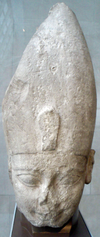 |
Brother and successor to Kamose, conquered north of Egypt from the Hyksos. | c. 1550–1525 BCE; Radiocarbon date range for the start of his reign is 1570–1544 BCE, the mean point of which is 1557 BCE[۵۷] |
| Djeserkare Amenhotep I |  |
- | 1541–1520 |
| Aakheperkare Thutmose I | 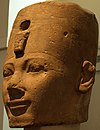 |
- | 1520–1492 |
| Aakheperenre Thutmose II | 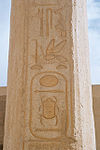 |
- | 1492–1479 |
| Maatkare Hatshepsut |  |
The second known female ruler, though quite possibly the seventh (the reigns of five other women are likely, but disputed)۔ Recent evidence suggests she died of bone cancer.[۵۸] | 1479–1458 |
| Menkheperre Thutmose III |  |
Often called the "نپولین of Egypt." Dominated early in his reign by his stepmother Hatshepsut; after she died, he began expanding Egyptian rule into the سرزمین شام۔ | 1479–1425 |
| Aakheperrure Amenhotep II |  |
- | 1425–1400 |
| Menkheperure Thutmose IV |  |
- | 1400–1390 |
| Nebmaatre Amenhotep III The Magnificent King |  |
Ruled Egypt at the peak of its power, surpassed all pharaohs in numbers of monuments built and statues erected. His mortuary temple was the largest ever built, only to be destroyed by Rameses II. Recent DNA testing proved he was the grandfather of Tutankhamun. | 1390–1352 |
| Neferkheperure-waenre Amenhotep IV/Akhenaten | 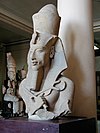 |
Founder of brief period of a solar-centered religion (Atenism)۔ His original name means "آمون is pleased." | 1352–1334 |
| Ankhkheperure Smenkhkare | 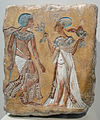 |
Co-regent and successor of Akhenaten. The identity of this individual is uncertain and disputed. Usually believed to be either a son or son-in-law of Akhenaten but sometimes identified as Akhenaten's wife Nefertiti۔ Other scholars distinguish two individuals between Akhenaten and Tutankhamun, namely Smenkhkare, who is then seen as male, and a female ruler, who is then most often identified as Akhenaten's eldest daughter Meritaten | 1334–1333 |
| Nebkheperure Tutankhaten/توتخ آمون |  |
Commonly believed to be the son of Akhenaten, probably reinstated the polytheistic religion and the name change reflects the change in primary deity from Aten to Amun. He is also known as the boy king. | 1333–1324 |
| Kheperkheperure Ay | 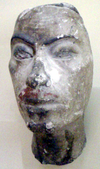 |
Close advisor to two and perhaps three of the pharaohs who ruled before him and was said to be the power behind the throne during Tutankhamun's reign. | 1324–1320 |
| Djeserkheperure-setpenre Horemheb | 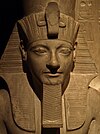 |
Former General and advisor to توتخ آمون۔ Obliterated images of the Amarna queens and kings (all except Amenhotep III and Tiye)۔ | 1320–1292 |
Nineteenth Dynasty
سودھوThe Nineteenth Dynasty ruled from 1292 to 1186 BC and includes one of the greatest pharaohs: رمسيس ثانی the Great:
| Name | Image | Comments | Dates |
|---|---|---|---|
| Menpehtire Ramesses I[۵۹] |  |
- | 1292–1290 |
| Menmaatre Seti I |  |
- | 1290–1279 |
| Usermaatre-setpenre Ramesses II the Great | 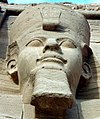 |
The ruler usually associated with موسیٰ علیہ السلام; he reached a stalemate with the Hittites at the Battle of Kadesh in 1275 BC, after which a peace treaty was signed in 1258 BC | 1279–1213 |
| Banenre Merenptah[۶۰] |  |
A stele describing campaigns in لیبیا and کنعان contains the only extant reference to "Israel" in Ancient Egyptian records. | 1213–1203 |
| Menmire-setpenre Amenmesse | 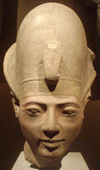 |
- | 1203–1200 |
| Userkheperure Seti II[۶۱] |  |
- | 1203–1197 |
| Sekhaenre/Akhenre Merenptah Siptah[۶۲] | 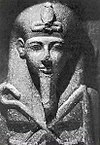 |
- | 1197–1191 |
| Satre-merenamun Tausret | 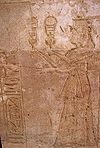 |
A rare female ruler also known as Tawosret in some places, she was probably the wife of Seti II.[۶۳] | 1191–1190 |
Twentieth Dynasty
سودھوThe Twentieth Dynasty ruled from 1190 to 1077 BC:
| Name | Image | Comments | Dates |
|---|---|---|---|
| Userkhaure Setnakht | 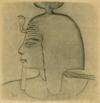 |
- | 1190–1186 |
| Usermaatre-meryamun Ramesses III | 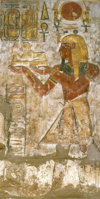 |
Fought the Sea Peoples in 1175 BC. Died assassinated in a harem plot. | 1186–1155 |
| User/Heqamaatre-setpenamun Ramesses IV | 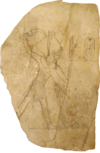 |
- | 1155–1149 |
| Usermaatre-sekheperenre Ramesses V |  |
- | 1149–1145 |
| Nebmaatre-meryamun Ramesses VI |  |
- | 1145–1137 |
| Usermaatre-setpenre-meryamun Ramesses VII |  |
- | 1137–1130 |
| Usermaatre-akhenamun Ramesses VIII |  |
- | 1130–1129 |
| Neferkare-setpenre Ramesses IX |  |
- | 1129–1111 |
| Khepermaatre-setpenptah Ramesses X[۶۴] |  |
- | 1111–1107 |
| Menmaatre-setpenptah Ramesses XI[۶۵] | 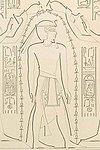 |
Ended rule sharing power with High Priest of Amun Herihor ruling in the south and Smendes I ruling in the north, a period known as wehem mesut۔[۶۶] | 1107–1077 |
Third Intermediate Period
سودھوThe Third Intermediate Period (1077–732 BC) marked the end of the New Kingdom after the collapse of the Egyptian empire. A number of dynasties of لیبیاn origin ruled, giving this period its alternative name of the Libyan Period.
Twenty-First Dynasty
سودھوThe Twenty-First Dynasty was based at Tanis and was a relatively weak group. Theoretically, they were rulers of all Egypt, but in practice their influence was limited to Lower Egypt. They ruled from 1069 to 943 BC
| Name | Image | Comments | Dates |
|---|---|---|---|
| Hedjkheperre-setpenre Nesbanebdjed[۶۷] | 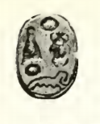 |
Also known as Smendes I | 1077–1051 |
| Neferkare Heqawaset Amenemnisu |  |
- | 1051–1047 |
| Aakheperre Pasebakhenniut I (Psusennes I) | 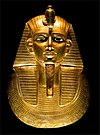 |
Also known as the Silver Pharaoh | 1047–1001 |
| Usermaatre Amenemope |  |
- | 1001–992 |
| Aakheperre Setepenre Osorkon (Osorkon the Elder) | 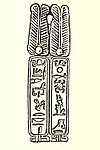 |
- * (Osochor ) | 992–986 |
| Netjerikheperre-setpenamun Siamun-meryamun |  |
- | 986–967 |
| Titkheperure Pasebakhenniut II (Psusennes II) | 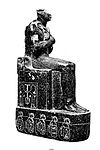 |
- | 967–943 |
Twenty-Second Dynasty
سودھوThe pharaohs of the Twenty-Second Dynasty were لیبیاns, ruling from around 943 to 728 BC:
| Name | Image | Comments | Dates |
|---|---|---|---|
| Hedjkheperre-setepenre Shoshenq I |  |
943–922 | |
| Sekhemkheperre Osorkon I | 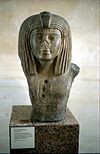 |
- | 922–887 |
| Heqakheperre Shoshenq II |  |
- | 887–885 |
| Takelot I |  |
- | 885–872 |
| Hedjkheperre Harsiese | 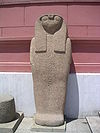 |
A rebel, at Thebes | 880–860 |
| Usermaatre-setepenamun Osorkon II | 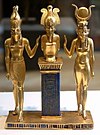 |
- | 872–837 |
| Usermaatre-setepenre Shoshenq III |  |
- | 837–798 |
| Shoshenq IV | - | 798–785 | |
| Usermaatre-setepenre Pami | 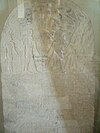 |
- | 785–778 |
| Aakheperre Shoshenq V |  |
- | 778–740 |
| Aakheperre-setepenamun Osorkon IV |  |
- | 740–720 |
Twenty-Third Dynasty
سودھوThe Twenty-Third Dynasty was a local group, again of لیبیاn origin, based at Herakleopolis and Thebes that ruled from 837 to c. 735 BC:
| Name | Image | Comments | Dates |
|---|---|---|---|
| Hedjkheperre-setpenre Takelot II |  |
Previously thought to be a 22nd Dynasty pharaoh, he is now known to be the founder of the 23rd | 837–813 |
| Usermaatre-setepenamun Pedubast | 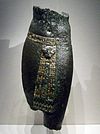 |
A rebel—seized Thebes from Takelot II | 826–801 |
| Usermaatre-setepenamun Iuput I | Co-regent with Pedubast | 812–811 | |
| Usermaatre Shoshenq VI | Successor to Pedubast | 801–795 | |
| Usermaatre-setepenamun Osorkon III |  |
Son of Takelot II; recovered Thebes, then proclaimed himself king | 795–767 |
| Usermaatre-setpenamun Takelot III |  |
Co-reign with his father Osorkon III for the first five years of his reign. | 773–765 |
| Usermaatre-setpenamun Rudamun |  |
Younger son of Osorkon III and brother of Takelot III. | 765–762 |
Rudamun was succeeded in Thebes by a local ruler:
| Name | Image | Comments | Dates |
|---|---|---|---|
| Menkheperre Ini |  |
Reigned at Thebes only | 762-? |
The Libu
سودھوNot recognised as a dynasty as such, the Libu were yet another group of western nomads (لیبیاns) who occupied the western Delta from 805 to 732 BC.
| Name | Image | Comments | Dates |
|---|---|---|---|
| Inamunnifnebu | 805–795 | ||
| ? | - | 795–780 | |
| Niumateped | - | 780–755 | |
| Titaru | - | 763–755 | |
| Ker | - | 755–750 | |
| Rudamon | - | 750–745 | |
| Ankhor | - | 745–736 | |
| Tefnakht | - | 736–732 |
Twenty-Fourth Dynasty
سودھوThe Twenty-fourth Dynasty was a short-lived rival dynasty located in the western Delta (Sais)، with only two Pharaoh ruling from 732 to 720 BC.
| Name | Image | Comments | Dates |
|---|---|---|---|
| Shepsesre Tefnakhte |  |
- | 732–725 |
| Wahkare Bakenrenef (Bocchoris) |  |
- | 725–720 |
Late period
سودھوThe Late Period runs from 732 BC to Egypt becoming a province of Rome 30 ق م میں، and includes periods of rule by Nubians, Persians، and مقدونیہ (قدیم مملکت)ians.
Twenty-fifth Dynasty
سودھوNubians invaded Lower Egypt and took the throne of Egypt under Piye although they already controlled Thebes and Upper Egypt in the early years of Piye's reign. Piye's conquest of Lower Egypt established the Twenty-fifth Dynasty which ruled until 656 BC.
| Name | Image | Comments | Dates |
|---|---|---|---|
| Usermaatre Piye |  |
King of Nubia; conquered Egypt in 20th year; full reign at least 24 years, possibly 30+ years | 752–721 according to Dan'el Kahn |
| Neferkare Shabaka |  |
- | 721–707/706 according to Rolf Krauss/David Warburton[۶۸] |
| Djedkaure Shebitku |  |
- | 707/706–690 according to Dan'el Kahn[۶۹] |
| Khuinefertemre Taharqa |  |
- | 690–664 |
| Bakare Tantamani | 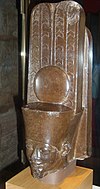 |
lost control of Upper Egypt in 656 BC when Psamtik I extended his authority into Thebes in that year. | 664–653 |
They were ultimately driven back into Nubia, where they established a kingdom at Napata (656–590)، and, later, at مرواہ (590 BC – 4th century AD)۔
Twenty-sixth Dynasty
سودھوThe Twenty-sixth Dynasty ruled from around 672 to 525 BC.[۷۰]
| Name | Image | Comments | Dates |
|---|---|---|---|
| Menkheperre Nekau I (Necho I) |  |
Was killed by an invading مملکت کوش force in 664 BC under Tantamani۔ Father of Psamtik I۔ | 672 – 664 BC |
| Wahibre Psamtik I (Psammetichus I) |  |
Reunified Egypt. Son of Necho I and father of نکوہ دوم۔ | 664 – 610 BC |
| Wehemibre Necho II (Necho II) |  |
Most likely the pharaoh mentioned in several books of the کتاب مقدس۔ Son of Psamtik I and father of Psamtik II۔ | 610 – 595 BC |
| Neferibre Psamtik II (Psammetichus II) |  |
Son of نکوہ دوم and father of Apries۔ | 595 – 589 BC |
| Haaibre Wahibre (Apries) |  |
Fled Egypt after Amasis II (who was a general at the time) declared himself pharaoh following a civil war. Son of Psamtik II۔ | 589 – 570 BC |
| Khnemibre Ahmose II (Amasis II) | 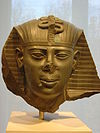 |
He was the last great ruler of Egypt before the Persian conquest. According to the Greek historian هيرودوت، he was of common origins. Father of Psamtik III۔ | 570 – 526 BC |
| Ankhkaenre Psamtik III (Psammetichus III) |  |
Son of Amasis II۔ Ruled for about six months before being defeated by the Persians in the Battle of Pelusium and subsequently executed. | 526 – 525 BC |
Twenty-seventh Dynasty
سودھوEgypt was conquered by the Persian Empire in 525 BC and annexed by the Persians until 404 BC. The Achaemenid shahs were acknowledged as pharaohs in this era, forming a "Twenty-seventh" Dynasty:
| Name | Image | Comments | Dates |
|---|---|---|---|
| Metsuire Cambyses (Cambyses II) |  |
Defeated Psamtik III at the Battle of Pelusium at 525 BC | 525 – 521 BC |
| Petubastis III | 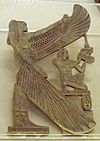 |
A native Egyptian rebel in the Delta | 522/21 – 520 BC |
| Smerdis (Bardiya) | Son of کورش اعظم | 522 – 521 BC | |
| Setutre Darius I the Great | 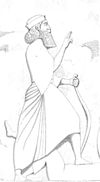 |
- | 521 – 486 BC |
| Xerxes I the Great | 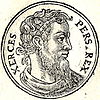 |
- | 486 – 465 BC |
| Artabanus the Hyrcanian | - | 465 – 464 BC | |
| اردشیراول Longhand |  |
- | 464 – 424 BC |
| Xerxes II | claimant | 424 – 423 BC | |
| Sogdianus | claimant | 424 – 423 BC | |
| Darius II |  |
424 – 404 BC |
Twenty-eighth Dynasty
سودھوThe Twenty-eighth Dynasty lasted only 6 years, from 404 to 398 BC, with one Pharaoh:
| Name | Image | Comments | Dates |
|---|---|---|---|
| Amyrtaeus | Descendant of the Saite pharaohs of the Twenty-sixth Dynasty; led a successful revolt against the Persians. | 404 – 398 BC |
Twenty-ninth Dynasty
سودھوThe Twenty-ninth Dynasty ruled from 398 to 380 BC:
| Name | Image | Comments | Dates |
|---|---|---|---|
| Baenre Nefaarud I |  |
Also known as Nepherites. Defeated Amyrtaeus in open battle and had him executed. | 398 – 393 BC |
| Psammuthes |  |
- | 393 BC |
| Khenemmaatre Hakor (Achoris) | 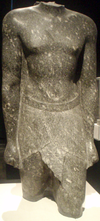 |
Overthrew his predecessor Psammuthes. Father of Nefaarud II. | 393 – 380 BC |
| Nefaarud II | Was deposed and likely killed by Nectanebo I after ruling for only 4 months. Son of Hakor. | 380 BC |
Thirtieth Dynasty
سودھوThe Thirtieth Dynasty ruled from 380 until Egypt once more came under Persian rule in 343 BC:
| Name | Image | Comments | Dates |
|---|---|---|---|
| Kheperkare Nekhtnebef (Nectanebo I) | 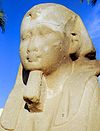 |
Also known as Nekhtnebef. Deposed and likely killed Nefaarud II, starting the last dynasty of native Egyptians. Father of Teos. | 380 – 362 BC |
| Irimaatenre Djedher (Teos) |  |
Co-regent with his father Nectanebo I from about 365 BC. Was overthrown by Nectanebo II with the aid of Agesilaus II of Sparta. | 362 – 360 BC |
| Senedjemibre Nakhthorhebyt (Nectanebo II) | 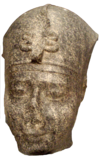 |
Last native ruler of ancient Egypt[۷۱] | 360 – 343 BC |
Thirty-first Dynasty
سودھوEgypt again came under the control of the Achaemenid Persians. After the practice of Manetho، the Persian rulers from 343 to 332 BC are occasionally designated as the Thirty-first Dynasty:
| Name | Image | Comments | Dates |
|---|---|---|---|
| Artaxerxes III | 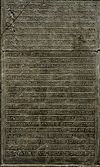
|
Egypt came under Persian rule for the second time | 343–338 BC |
| Artaxerxes IV Arses | Only reigned in Lower Egypt | 338–336 BC | |
| Khababash | 
|
Rebel pharaoh who led an invasion in Nubia | 338–335 BC |
| Darius III | 
|
Upper Egypt returned to Persian control in 335 BC | 336–332 BC |
Argead Dynasty
سودھوThe مقدونیہ (قدیم مملکت)ians under سکندر اعظم ushered in the Hellenistic period with his conquest of Persia and Egypt. The Argeads ruled from 332 to 309 BC:
| Name | Image | Comments | Dates |
|---|---|---|---|
| Setepenre-meryamun Alexander III (Alexander the Great) | 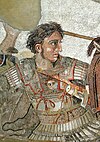 |
مقدونیہ (قدیم مملکت) conquered Persia and Egypt | 332–323 BC |
| Philip III Arrhidaeus |  |
Feeble-minded half-brother of Alexander III the Great | 323–317 BC |
| Haaibre Alexander IV |  |
Son of Alexander III the Great and Roxana | 317–309 BC |
Ptolemaic Dynasty
سودھوThe second Hellenistic dynasty, the Ptolemies، ruled Egypt from 305 BC until Egypt became a province of Rome in 30 BC (whenever two dates overlap, that means there was a co-regency)۔ The most famous member of this dynasty was قلوپطرہ، who in modern times is known simply as قلوپطرہ who was successively the consort of جولیس سیزر and after Caesar's death, of مارک انتھونی، and had children with both of them. Cleopatra strove to create a dynastic and political union between Egypt and Rome but the assassination of Caesar and the defeat of Mark Antony doomed her plans. Caesarion (Ptolemy XV Philopator Philometor Caesar) was the last king of the Ptolemaic dynasty of Egypt, he reigned jointly with his mother Cleopatra VII of Egypt, from ستمبر 2, 47 BC. He was the eldest son of Cleopatra VII, and possibly the only son of جولیس سیزر، after whom he was named. Between the alleged death of Cleopatra, on اگست 12, 30 BC, up to his own alleged death on اگست 23, 30 BC, he was nominally the sole pharaoh. It is tradition that he was hunted down and killed on the orders of Octavian, who would become the رومی شہنشاہ آگسٹس، but the historical evidence does not exist.
| Name | Image | Comments | Dates |
|---|---|---|---|
| Setepenre-meryamun Ptolemy I Soter | 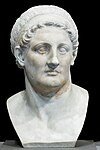
|
Abdicated in 285 BC; died in 283 BC | 305–285 BC |
| Berenice I | 
|
Wife of Ptolemy I | ?–285 BC |
| Weserkare-meryamun Ptolemy II Philadelphos | 
|
- | 288–246 BC |
| Arsinoe I | 
|
Wife of Ptolemy II | 284/281-c. 274 BC |
| Arsinoe II | 
|
Wife of Ptolemy II | 277–270 BC |
| Ptolemy III Euergetes I | 
|
- | 246–222 BC |
| Berenice II | 
|
Wife of Ptolemy III | 244/243–222 BC |
| Ptolemy IV Philopator | 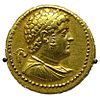
|
- | 222–204 BC |
| Arsinoe III | 
|
Wife of Ptolemy IV | 220–204 BC |
| Hugronaphor | Revolutionary Pharaoh in the South | 205–199 BC | |
| Ankhmakis | Revolutionary Pharaoh in the South | 199–185 BC | |
| Ptolemy V Epiphanes | 
|
Upper Egypt in revolt 207–186 BC | 204–180 BC |
| Cleopatra I | 
|
Wife of Ptolemy V, co-regent with Ptolemy VI during his minority | 193–176 BC |
| Ptolemy VI Philometor | 
|
Died 145 BC | 180–164 BC |
| Cleopatra II | 
|
Wife of Ptolemy VI | 175–164 BC |
| Ptolemy VIII Euergetes II | 
|
Proclaimed king by اسکندریہns in 170 BC; ruled jointly with Ptolemy VI Philometor and Cleopatra II from 169 to 164 BC. Died 116 BC | 171–163 BC |
| Ptolemy VI Philometor | 
|
Egypt under the control of Ptolemy VIII 164 BC–163 BC; Ptolemy VI restored 163 BC | 163–145 BC |
| Cleopatra II | 
|
Married Ptolemy VIII; led revolt against him in 131 BC and became sole ruler of Egypt. | 163–127 BC |
| Ptolemy VII Neos Philopator | Proclaimed co-ruler by father; later ruled under regency of his mother Cleopatra II | 145–144 BC | |
| Ptolemy VIII Euergetes II | 
|
Restored | 145–131 BC |
| Cleopatra III | 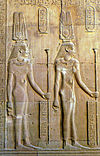
|
Second wife of Ptolemy VIII | 142–131 BC |
| Ptolemy Memphitis | Proclaimed King by Cleopatra II; soon killed by Ptolemy VIII | 131 BC | |
| Ptolemy VIII Euergetes II | 
|
Restored | 127–116 BC |
| Cleopatra III | 
|
Restored with Ptolemy VIII; later co-regent with Ptolemy IX and X. | 127–107 BC |
| Cleopatra II | 
|
Reconciled with Ptolemy VIII; co-ruled with Cleopatra III and Ptolemy until 116. | 124–116 BC |
| Ptolemy IX Soter II | 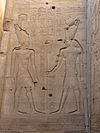
|
Died 80 BC | 116–110 BC |
| Cleopatra IV | Shortly married to Ptolemy IX, but was pushed out by Cleopatra III | 116–115 BC | |
| Ptolemy X Alexander I | 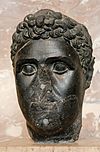
|
Died 88 BC | 110–109 BC |
| Berenice III | Forced to marry Ptolemy XI; murdered on his orders 19 days later | 81–80 BC | |
| Ptolemy XI Alexander II | Young son of Ptolemy X Alexander; installed by Sulla; ruled for 80 days before being lynched by citizens for killing Berenice III | 80 BC | |
| Ptolemy XII Neos Dionysos (Auletes) | 
|
Son of Ptolemy IX; died 51 BC | 80– 58 BC |
| Cleopatra V Tryphaena | Wife of Ptolemy XII, mother of Berenice IV | 79–68 BC | |
| Cleopatra VI | Daughter of Ptolemy XII | 58–57 BC | |
| Berenice IV | Daughter of Ptolemy XII; forced to marry Seleucus Kybiosaktes, but has him strangled. Joint rule with Cleopatra VI until 57 BC. | 58–55 BC | |
| Ptolemy XII Neos Dionysos | 
|
Restored; reigned briefly with his daughter Cleopatra VII before his death | 55–51 BC |
| قلوپطرہ | 
|
Jointly with her father Ptolemy XII, her brother Ptolemy XIII, her brother-husband Ptolemy XIV, and her son Ptolemy XV; also known simply as Cleopatra | 51–30 BC |
| Ptolemy XIII | Brother of Cleopatra VII | 51–47 BC | |
| Arsinoe IV | In opposition to Cleopatra VII | 48–47 BC | |
| Ptolemy XIV | 
|
Younger brother of Cleopatra VII and Ptolemy XIII | 47–44 BC |
| Ptolemy XV | 
|
Infant son of Cleopatra VII; aged 3 when proclaimed co-ruler with Cleopatra. Last known ruler of ancient Egypt when Rome took over. | 44–30 BC |
حوالے
سودھو- ↑ ۱.۰ ۱.۱ Clayton 1995، p. 217. "Although paying lip-service to the old ideas and religion, in varying degrees, pharaonic Egypt had in effect died with the last native pharaoh, Nectanebo II in 343 BC"
- ↑ The Encyclopedia of World History. p. 30
- ↑ ۳.۰ ۳.۱ ۳.۲ ۳.۳ ۳.۴ ۳.۵ ۳.۶ ۳.۷ Breasted (1909) p.36
- ↑ Rice (1999) p.86
- ↑ Wilkinson (1999) pp.57f.
- ↑ Shaw (2000) p.196
- ↑ ۷.۰ ۷.۱ Wolfgang Helck: Untersuchungen zur Thinitenzeit (Agyptologische Abhandlungen)، ISBN 3-447-02677-4, O. Harrassowitz (1987)، p. 124
- ↑ Wilkinson (1999) pp. 83–84
- ↑ Wilkinson (1999) p. 84
- ↑ Jochem Kahl: Ra is my Lord: Searching for the Rise of the Sun God at the Dawn of Egyptian History۔ Harrassowitz, Wiesbaden 2007, ISBN 3-447-05540-5, page 12–14 & 74.
- ↑ Wilkinson (1999) p. 79
- ↑ Wilkinson (1999) pp. 87–88
- ↑ Pascal Vernus, Jean Yoyotte, The Book of the Pharaohs، Cornell University Press 2003, p.27
- ↑ Jürgen von Beckerath: Handbuch der ägyptischen Königsnamen.۔ Deutscher Kunstverlag, München/Berlin 1984, ISBN 3-422-00832-2, page 171.
- ↑ [۱] Archived 2009-01-07 at the وے بیک مشین Seth-Peribsen
- ↑ ۱۶.۰ ۱۶.۱ Darell D. Baker: The Encyclopedia of the Pharaohs: Volume I – Predynastic to the Twentieth Dynasty 3300–1069 BC، Stacey International, ISBN 978-1-905299-37-9, 2008
- ↑ [۲] King Khasekhem
- ↑ [۳] King Khasekhemwy
- ↑ Toby Wilkinson, Early Dynastic Egypt, Routledge, 1999, pp.83 & 95
- ↑ Toby Wilkinson, Royal Annals of Ancient Egypt, pp.79 & 258
- ↑ Verner (2001)
- ↑ Christopher Bronk Ramsey et al.، [url="http://dx.doi.org/10.1126/science.1189395"]Radiocarbon-Based Chronology for Dynastic Egypt[/url]، [i]Science[/i] 18 جون 2010: Vol. 328. no. 5985, pp. 1554–1557
- ↑ Clayton (1994) p.32
- ↑ Clayton (1994) p.42
- ↑ Miroslav Verner (2000): Who was Shepseskara, and when did he reign?، in: Miroslav Bárta, Jaromír Krejčí (editors): Abusir and Saqqara in the Year 2000، Academy of Sciences of the Czech Republic, Oriental Institute, Prague, ISBN 80-85425-39-4, p. 581–602, available online۔
- ↑ Dodson & Hilton (2004) p.73
- ↑ Ryholt & Bardrum (2000) pp.87–100.
- ↑ Jürgen von Beckerath: Handbuch der ägyptischen Königsnamen، Münchner ägyptologische Studien, Heft 49, Mainz : P. von Zabern, 1999, ISBN 3-8053-2591-6, available online Archived 2015-12-22 at the وے بیک مشین
- ↑ Kim Ryholt: "The Late Old Kingdom in the Turin King-list and the Identity of Nitocris"، Zeitschrift für ägyptische, 127, 2000, p. 99
- ↑ ۳۰.۰ ۳۰.۱ Turin Kinglist, Columns IV,18 to V,10، Ancient Egypt dot org۔ Accessed 10 فروری 2010.
- ↑ Margaret Bunson: Encyclopedia of Ancient Egypt، Infobase Publishing, 2009, ISBN 978-1-4381-0997-8, available online, see p. 181
- ↑ Labib Habachi: King Nebhepetre Menthuhotep: his monuments, place in history, deification and unusual representations in form of gods، in: Annales du Service des Antiquités de l'Égypte 19 (1963)، pp. 16–52
- ↑ Wolfram Grajetzki (2006) pp. 23–25
- ↑ Wolfram Grajetzki (2006) pp. 25–26
- ↑ [۴] Amenemhat I
- ↑ Wolfram Grajetzki (2006) pp. 28–35
- ↑ Murnane (1977) p.2
- ↑ Murnane (1977) p.7
- ↑ Murnane (1977) p.9
- ↑ Josef Wegner, The Nature and Chronology of the Senwosret III–Amenemhat III Regnal Succession: Some Considerations based on new evidence from the Mortuary Temple of Senwosret III at Abydos، JNES 55, Vol.4, (1996)، pp.251
- ↑ Wolfram Grajetzki (2006) pp. 56–61
- ↑ "Amenemhat IV Maakherure (1807/06-1798/97 BCE)"۔ Digital Egypt for Universities
- ↑ Grajetzk (2006) pp.61-63
- ↑ ۴۴.۰۰ ۴۴.۰۱ ۴۴.۰۲ ۴۴.۰۳ ۴۴.۰۴ ۴۴.۰۵ ۴۴.۰۶ ۴۴.۰۷ ۴۴.۰۸ ۴۴.۰۹ ۴۴.۱۰ ۴۴.۱۱ ۴۴.۱۲ ۴۴.۱۳ ۴۴.۱۴ ۴۴.۱۵ ۴۴.۱۶ ۴۴.۱۷ ۴۴.۱۸ ۴۴.۱۹ ۴۴.۲۰ ۴۴.۲۱ ۴۴.۲۲ ۴۴.۲۳ ۴۴.۲۴ ۴۴.۲۵ ۴۴.۲۶ ۴۴.۲۷ ۴۴.۲۸ ۴۴.۲۹ ۴۴.۳۰ ۴۴.۳۱ ۴۴.۳۲ ۴۴.۳۳ ۴۴.۳۴ ۴۴.۳۵ ۴۴.۳۶ ۴۴.۳۷ ۴۴.۳۸ ۴۴.۳۹ ۴۴.۴۰ K.S.B. Ryholt, The Political Situation in Egypt during the Second Intermediate Period, c.1800-1550 BC، Carsten Niebuhr Institute Publications, vol. 20. Copenhagen: Museum Tusculanum Press, 1997
- ↑ ۴۵.۰ ۴۵.۱ Thomas Schneider: Lexikon der Pharaonen، Albatros, Düsseldorf 2002, ISBN 3-491-96053-3
- ↑ Thomas Schneider: Lexikon der Pharaonen، Albatros, 2002
- ↑ ۴۷.۰۰ ۴۷.۰۱ ۴۷.۰۲ ۴۷.۰۳ ۴۷.۰۴ ۴۷.۰۵ ۴۷.۰۶ ۴۷.۰۷ ۴۷.۰۸ ۴۷.۰۹ ۴۷.۱۰ ۴۷.۱۱ ۴۷.۱۲ K.S.B. Ryholt: The Political Situation in Egypt during the Second Intermediate Period، c.1800-1550 BC, Carsten Niebuhr Institute Publications, vol. 20. Copenhagen: Museum Tusculanum Press, 1997
- ↑ ۴۸.۰ ۴۸.۱ Kings of the 2nd Intermediate Period
- ↑ Detlef Franke: Zur Chronologie des Mittleren Reiches. Teil II: Die sogenannte Zweite Zwischenzeit Altägyptens، In Orientalia 57 (1988)، p. 259
- ↑ Ryholt, K.S.B. (1997). The Political Situation in Egypt During the Second Intermediate Period, C. 1800-1550 B.C.. Museum Tusculanum Press, 164. ISBN 8772894210.
- ↑ Lua error in ماڈیول:Citation/CS1/Date_validation/ar at line 45: attempt to compare number with nil.
- ↑ ۵۲.۰ ۵۲.۱ Marcel Marée: A sculpture workshop at Abydos from the late Sixteenth or early Seventeenth Dynasty، in: Marcel Marée (editor): The Second Intermediate period (Thirteenth-Seventeenth Dynasties)، Current Research, Future Prospects، Leuven, Paris, Walpole, MA. 2010 ISBN 978-90-429-2228-0. p. 247, 268
- ↑ ۵۳.۰ ۵۳.۱ Jürgen von Beckerath: Untersuchungen zur politischen Geschichte der Zweiten Zwischenzeit in Ägypten، Glückstadt, 1964
- ↑ ۵۴.۰ ۵۴.۱ ۵۴.۲ ۵۴.۳ Jürgen von Beckerath: Chronologie des pharaonischen Ägyptens، Münchner Ägyptologische Studien 46. Mainz am Rhein, 1997
- ↑ Jürgen von Beckerath: Handbuch der ägyptischen Königsnamen، Münchner ägyptologische Studien 49, Mainz 1999.
- ↑ Wolfgang Helck, Eberhard Otto, Wolfhart Westendorf, Stele – Zypresse: Volume 6 of Lexikon der Ägyptologie, Otto Harrassowitz Verlag, 1986, Page 1383
- ↑ Christopher Bronk Ramsey et al.، Radiocarbon-Based Chronology for Dynastic Egypt، Science 18 جون 2010: Vol. 328. no. 5985, pp. 1554–1557.
- ↑ Tooth clinches identification of Egyptian queen
- ↑ Lua error in ماڈیول:Citation/CS1/Date_validation/ar at line 45: attempt to compare number with nil.
- ↑ Lua error in ماڈیول:Citation/CS1/Date_validation/ar at line 45: attempt to compare number with nil.
- ↑ Lua error in ماڈیول:Citation/CS1/Date_validation/ar at line 45: attempt to compare number with nil.
- ↑ Lua error in ماڈیول:Citation/CS1/Date_validation/ar at line 45: attempt to compare number with nil.
- ↑ "Tausret"
- ↑ Grimal (1992) p.291
- ↑ Lua error in ماڈیول:Citation/CS1/Date_validation/ar at line 45: attempt to compare number with nil.
- ↑ Shaw (ed), Ian (2000). The Oxford History of Ancient Egypt. Oxford: Oxford University Press, 309.
- ↑ Cerny p.645
- ↑ R. Krauss and D.A. Warburton، "Chronological Table for the Dynastic Period" in Erik Hornung، Rolf Krauss & David Warburton (editors)، Ancient Egyptian Chronology (Handbook of Oriental Studies)، Brill, 2006. p.494
- ↑ Dan'el Kahn, "The Inscription of Sargon II at Tang-i Var and the Chronology of Dynasty 25," Orientalia 70 (2001)، pp.1-18
- ↑ Lua error in ماڈیول:Citation/CS1/Date_validation/ar at line 45: attempt to compare number with nil.
- ↑ "Nakhthorhebyt"۔ Digital Egypt for Universities۔ اخذ شدہ بتاریخ مارچ 1, 2011